| |
|
|
|
|
| |
Digital Media |
|
|
|
| |
|
|
|
|
| |
Save Cathedral Grove |
|
Beyond the Cutting Edge |
|
| |
Tour of Cathedral Grove |
|
Save the Upper Walbran Valley |
|
| |
World's Highest Treesit |
|
Save the East Creek Rainforest |
|
| |
Cathedral Grove Panorama |
|
Killing An Ancient Douglas Fir |
|
| |
Tallest Tree in Cathedral Grove |
|
Phoney Manliness and Big Tree Felling |
|
| |
The Art of Rainforests |
|
Tree Songs |
|
| |
|
|
|
|
| |
|
|
| |
|
|
|
|
| |
Save Cathedral Grove
Save Cathedral Grove (QuickTime). 6.49 minutes. 2001. Also formatted for RealPlayer and
WindowsMedia. Presents the 2001 protest against the government's plan to build a parking lot in the tiny and endangered ancient rainforest ecosystem remnant known as Cathedral Grove (right) in British Columbia (BC). The grassroots movement to save Cathedral Grove gained momentum when Weyerhaeuser destroyed much of the protective forest buffer of the big trees in 2000. This act of corporate vandalism diminished the biological integrity of the Grove and increased the risk of blowdown. Interviews with senior treehugger Ruth Masters, Green Party leader Sergio Paone, biologist Mike Stini and forest activist Ingmar Lee. By Phil Carson: Screen Weavers. |
|
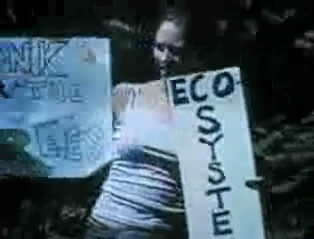 |
|
| |
|
|
 |
|
| |
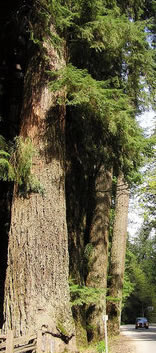 |
They paved paradise
And put up a parking lot
With a pink hotel, a boutique
And a swinging hot spot
Don't it always seem to go
That you don't know what you've got
Till it's gone
They took all the trees
Put em in a tree museum
And they charged the people
A dollar and a half just to see em
Don't it always seem to go
That you don't know what you've got
Till it's gone
They paved paradise
And put up a parking lot
Joni Mitchell, 1970
Left: Big trees in Cathedral Grove
British Columbia, Canada |
|
|
Left: The video's soundtrack includes a well known and often recorded song, the reflective lyrics of which describe the tragedy of big tree extermination. See Joni Mitchell performing her famous ode to idealism in 1970:
Big Yellow Taxi.
With its 800 year old big trees, Cathedral Grove is a recognized nature treasure for all of humanity. Yet ever since it was "discovered" by settlers at the end of the 19th century, there has been a lack of government initiative to protect the big trees from the voracious logging industry that has havocked the rainforests of Vancouver Island.
The idea of further wrecking Cathedral Grove's rare and endangered habitat to to make way for a huge parking lot adds insult to injury, aggravating the original injustice of settler society which grabbed the rich forest lands from the indigenous peoples and illegally handed them over to profiteers and corporate nature wreckers. |
|
| |
|
|
|
|
| |
|
|
| |
|
|
|
|
| |
Tour of Cathedral Grove
Tour of Cathedral Grove (QuickTime). 60 seconds. 2001. Biologist Ron Buchart (right) introduces the giant trees and points out that in Europe, Cathedral Grove would be preserved as a national monument and carefully stewarded. Instead misinformed park officials plan to build new trails and a parking lot to accomodate more visitors using the argument of public safety. Preserving the big trees and their habitat is urgent as 99 percent of this ecosystem type on Vancouver Island has already gone as a result of the forest destruction corporations (MacMillan Bloedel, Weyerhaeuser, Western Forest Products, TimberWest, Interfor, et al). By Richard Boyce: Island Bound Media Works. |
|
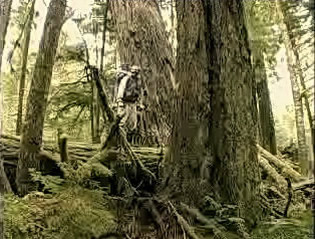 |
|
| |
|
|
 |
|
| |
|
|
| |
|
|
|
|
| |
World's Highest Treesit: 60 Metres
World's Highest Treesit (QuickTime). 48 sec. 2004. Forest activists protected Cathedral Grove from 9 February 2004 to 5 April 2006 when the BC government finally backed down from its misguided plan to build a 150 car parking lot in the Douglas fir ecosystem that has nurtured the big trees for at least half a millenium. Treesitter Ingmar Lee is filmed on a platform built 60 metres up an ancient Douglas fir, at the time the world's highest treesit (right). From this incredible position high above Cathedral Grove, the rich biodiversity of its ancient canopy is evident. Note the platform's height by the filmmaker's shoe in the left bottom corner of the photo. By Richard Boyce: Island Bound Media Works. |
|
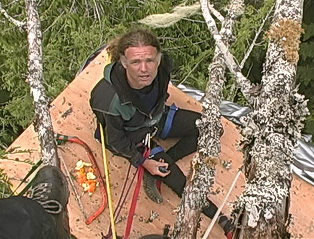 |
|
| |
|
|
|
|
| |
|
|
| |
|
|
|
|
| |
Cathedral Grove Panorama
Cathedral Grove Panorama (QuickTime). 2002. Panorama by Robert Berdan, a nature photographer who is concerned with environmental protection (right). "In 2002 I visited Parkinson's Creek on Vancouver Island, a place my guide book said is a 'must see.' When I arrived I saw a clearcut forest with a sign in the parking lot that said 'Clearcut habitat for sun loving animals.' There were obscenities carved into the sign by other angry visitors. The ancient rainforests are some of the most beautiful and magnificent places on earth with trees 15 to 30 feet in diameter and ranging from 500 to 1000 years or more in age – once cut they will be gone forever" Robert Berdan:
Moods of Nature. |
|
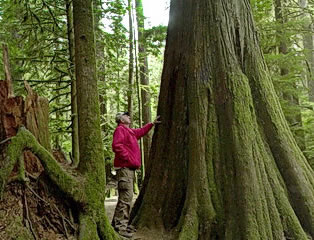 |
|
| |
|
|
|
|
| |
 |
|
| |
|
|
 |
|
| |
|
|
| |
|
|
|
|
| |
Tallest Tree in Cathedral Grove
Tallest Tree in Cathedral Grove (QuickTime). A panorama by Don Bain, University of Berkeley geographer (right). His Virtual Guidebook presents photos that " show you exactly what it is like to be in a particular spot – you can look in any direction, all the way around. It's the next best thing to being there." Cathedral Grove photos include: On the Trail; Sword Ferns; Windthrow of Huge Old Fir Trees; Devils Club; Biggest Tree. Other ancient forest panoramas (and clearcuts) include those with the following titles: Clearcut Above Nitinat Lake; On the Trail; Boardwalk Through the Spruce Forest; Entrance to the Park; The Heaven Tree; Carmanah Creek; Randy Stoltmann Memorial Grove. |
|
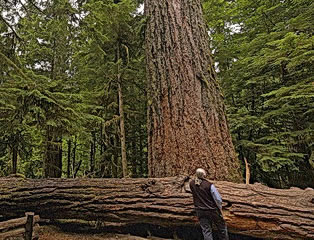 |
|
| |
|
|
|
|
| |
|
|
| |
|
|
|
|
| |
Beyond the Cutting Edge
Beyond
the Cutting Edge: Part I and
Part II and
Part III and
Part IV and
Part V
(QuickTime). 20 minute video in five four minute sections. 2003. By Ingmar Lee with production assistance by David White. Follows the forest activist on an excursion by float plane to Klaskish Inlet and East Creek on the remote Northwest Coast of Vancouver Island, in Quatsino Territory. Since 1997 this rare surviving wilderness rainforest ecosystem has been ravaged by a succession of big multinational logging companies (Interfor, TimberWest, Western Forest Products) and their subcontractors. East Creek urgently requires protection. For stillshots and a report in German, see NaturSchatz. |
|
 |
|
| |
|
|
|
|
| |
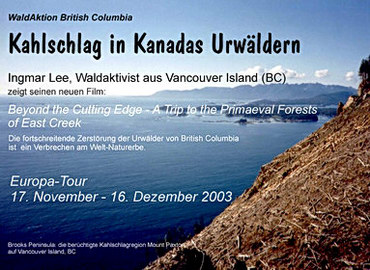 "Kahlschlag in Kanadas Urwaeldern" (Click to enlarge)
"Kahlschlag in Kanadas Urwaeldern" (Click to enlarge) |
|
WaldAktion BC Beyond the Cutting Edge was premiered by Ingmar Lee during a European tour of Germany, Sweden and Denmark in 2003 organized by the History of Science Institute at the University of Goettingen. More on Ingmar Lee's tour is on the website of the German environmental network for forest preservation: NaturSchatz.
During the 21 years he worked as a tree planter in BC, Ingmar Lee has witnessed the defiling of the primaeval forests as they were liquidated and transformed into industrial cutblocks and chemical dependent tree farms by the international logging industry. He describes this senseless devastation and his disdain for the logging industry's Swedish designed pigs blood product:
Plantskydd. |
|
| |
|
|
 |
|
| |
|
|
| |
|
|
|
|
| |
The Art of Rainforests
The Art of Rainforests (Windows Media). 24 minutes. 2005. Music by John Mills Cockell. "Experience the densest biomass on the planet Earth by entering the Ancient Rainforest on the West Coast of Vancouver Island, British Columbia, Canada. There is a magical art to this fragile environment on the brink of extinction. This film allows the natural world to speak for itself by revealing the beauty and diversity of a forest environment that both relies upon and continues the cycle of rain that provides for life on this planet." See also a video of the canopy of the endangered big trees of Klaskish Inlet and East Creek:
Aerial Rainforest Gardens. Videos by Richard Boyce: Island Bound Media Works. |
|
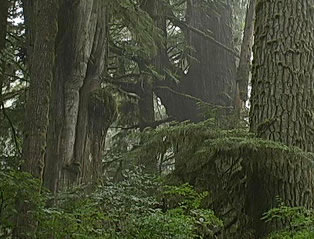 |
|
| |
|
|
|
|
| |
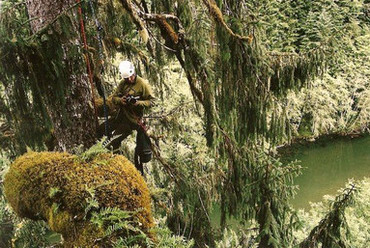 Richard Boyce in Klaskish rainforest canopy, 2009
Richard Boyce in Klaskish rainforest canopy, 2009
|
|
Richard Boyce hopes that his films will take viewers "on
a journey into a place that nobody knows exists, by climbing high up into the
canopy of one of the densest rainforests on this planet. Gliding between the
tops of gigantic trees to reveal aerial gardens that have taken centuries to
evolve into lush ecosystems that are teeming with life. An abundance of life,
flourishing at such great heights, forms a dense canopy that grows hundreds
of feet above the forest floor. All of this in a wilderness so remote that
few have any idea that it even exists. . ."
Boyce views his films as an environmental plea to stop the devastation of the
irreplaceable Klaskish rainforest which the filmmaker warns: "is on the
brink of extinction at the hands of Man." |
|
| |
|
|
|
|
| |
|
|
| |
|
|
|
|
| |
Save the Upper Walbran Valley
Save the Upper Walbran Valley (QuickTime). 6:40 minutes. 2004. Western Canada Wilderness Committee documentary film by Jeremy Sean Williams. Ken Wu tours the shocking Weyerhaeuser cutblocks where rare and endangered ancient trees have been ruthlessly destroyed. Some 500 citizens took part in a protest action here in 2004 (right). This precious old growth rainforest remnant is less than a three hour drive from Victoria, capital city of British Columbia (BC). Further environmental tours to 2010 document the continued quasi legal, barbaric clearcut logging of the Upper Walbran Valley by various logging companies including Teal Jones and Western Forest Products. |
|
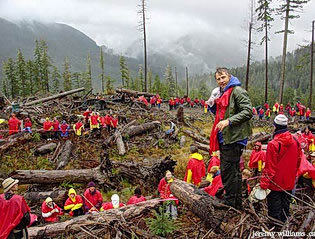 |
|
| |
|
|
|
|
| |
|
|
| |
|
|
|
|
| |
Save the East Creek Rainforest
Save the East Creek Rainforest (QuickTime). 13 minutes. 2003. Filmed by Sonia and Magali Ringoot. Documents a Western Canada Wilderness Committee expedition to East Creek by Joe Foy and Ken Wu. Shows the carnage by Weyerhaeuser of endangered ancient trees such as a rare thousand year yellow cedar (right). Joe Foy: "The Klaskish up until 1997 was one of a handful of unlogged valleys on Vancouver Island. Five years ago International Forest Products (Interfor) got the go ahead to log the Klaskish Watershed. When we saw how the Klaskish had been butchered it made us even more determined to see the logging road construction halted in the East Creek Valley." |
|
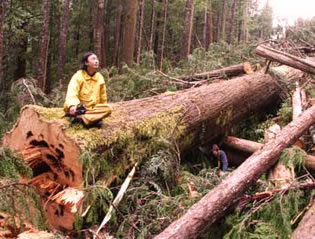 |
|
| |
|
|
 |
|
| |
|
|
| |
|
|
|
|
| |
Killing An Ancient Douglas Fir
Killing An Ancient Douglas Fir (QuickTime). 10 seconds. 2006. Shot in Errington on Vancouver Island. Shows how long it takes for a 500 year old Douglas fir to come crashing to the ground (right). The slaughtered giant was about 80 m (250 ft) tall and 3 m (9 ft) across at the butt. To give a perspective of her mighty size, the surrounding trees in the photo (right) are approximately 40 m (125 ft) tall. Not much has changed in the colonial mindset of BC since 1920 when logging companies like Capilano Timber took pride in destroying the Douglas fir giants (below right) in the Capilano Watershed, among them the world's tallest specimens. By Richard Boyce, Island Bound Media Works. |
|
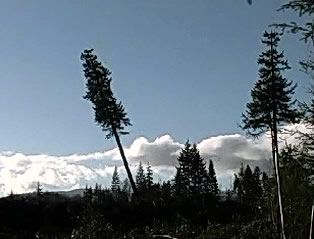 |
|
| |
|
|
|
|
| |

Mechanical progress has made it so that a single
worker can fell many acres of trees per day while another worker
can yard the same to the road edge. A couple of truckers and the
job is done. An
entire forest in exchange for only a minimal number of jobs. . .
I noticed several old growth veteran trees; left behind by the first
loggers in the 1950s, they provided the area with seeds for an entire
generation of trees. This was standard practice in those days and
as a result massive Douglas fir trees still grow sporadically around
the entire region.
Then I heard a chainsaw at the base of a group
of veteran trees which towered to a height of over 250 feet.
Each veteran was easily over 6 feet across at the butt. For more
than five minutes the roar of the chainsaw continued as smoke billowed
from the base of the tree. Slowly, the giant began to tilt over,
gained speed and made a thunderous crash against the floor of the
clearcut. This process was repeated until only three trees stood
in the entire clearcut spread out over 80 acres"
Ancient
Trees Felled. |
|
Richard Boyce
(left) describes the clearcutting near his home in Errington on
Vancouver Island in 2006: "TimberWest
is currently logging the entire area with feller buncher machines.
. . I can hear the sharp whirr of the feller bunch cutter as the
blade rips through the trunk of a tree followed by the crash of
the tree as it is thrown to the ground. This is repeated every
30 to 40 seconds, 24 hours a day, seven days a week.
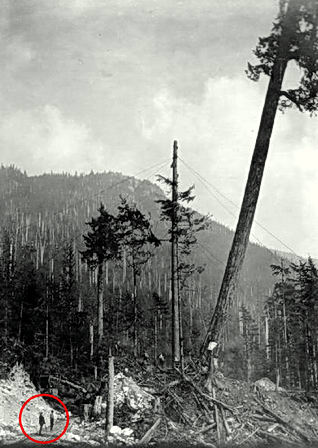
"Felling a BC Fir Tree," 1920.
Photo: University of British Columbia |
|
| |
|
|
 |
|
| |
|
|
| |
|
|
|
|
| |
Phoney Manliness and Big Tree Felling
Cutting down an ancient big tree is an act of killing, similar to the blood sport of big game hunting. Celebrating this act in videos (see the YouTube Gallery below) is no different than what the sportsman does when he poses beside his freshly killed big game animal for a trophy photo. Both are a form of male iconography that tributes the vanguishing of nature. This phoney manliness is a bygone mindset that has no place in our ecologically stressed and overpopulated world. The Oregon logging company owner who puts a photo of himself with a big tree corpse on the Internet (right) exposes an abusive attitude toward nature that has resulted in the near extermination of big trees in his state. |
|
 |
|
| |
|
|
|
|
| |
Lumberjack Song (click right)
 |
|
 |
|
The Lumberjack Song is one of the best known and most popular songs by the Monty Python comedy troupe. It first appeared on the ninth episode of Monty Python's Flying Circus on BBC1 in 1969.
The common theme is that of an average man (Michael
Palin) who expresses dissatisfaction with his current job and announces " I
wanted to be lumberjack! . . . leaping from tree to tree.". Ripping off
his coat to reveal a red flannel shirt, he walks over to a stage with a coniferous
forest backdrop and begins to sing about the wonders of being a lumberjack
in British Columbia. . . Then, he is unexpectedly backed up by a small choir
of male singers, all dressed as Canadian Mounties. wikipedia.org/wiki/The_Lumberjack_Song |
|
|
| |
|
|
 |
|
| |
|
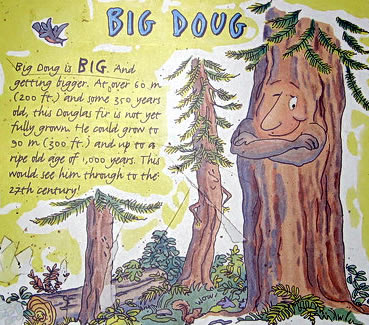 Big Doug park sign, BC Forest Services
Big Doug park sign, BC Forest Services |
Advocates of the logging industry maintain
that timber must be harvested as a renewable resource like an agricultural
crop. Due to this strategy, all but four percent of the primaeval forests
of California, Oregon and Washington have been clearcut logged. Today's surviving
big trees are rare and endangered and it is unethical to fell them for the
wood products industry.
Big matriarch trees can withstand fire and live up to 2,000 years:
by exterminating them for short term profit, the rainforest biodiversity
is forever degraded.
The heroic logger myth so pervasive in BC (right) disguises the
plundering of forest biodiversity that has evolved over thousands
of years and that can never be replaced by industrial forestry. |
|
Left: "Big
Doug."
BC Forest Services makes the Douglas firs into a caricature. These trees
can live up to 2,000 years. They are a symbol of the irreplaceable natural
heritage that has today vanished from most of the Northwest Coast. Surviving
trees require protection, and killing of them for sport and profit is an
act of nature desecration that will be condemned by future generations.

Lumberjack sculpture and tourist attraction.
British Columbia |
|
| |
|
|
|
|
|
|
|
YouTube Videos of Big Tree Demolition in British Columbia |
 |
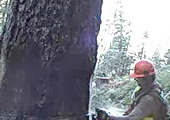 |
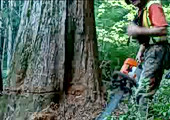 |
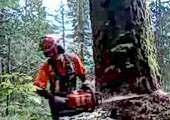 |
"Falling Big Red Cedar" |
"West Coast Falling" |
"Tree Huggers Ball" |
"West Coast Logging" |
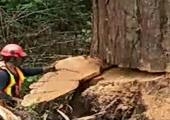 |
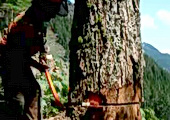 |
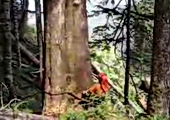 |
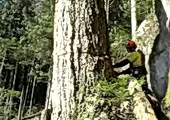 |
"Downing a Big Tree" |
"The Last Stroke" |
"6 Footer Tree Falling" |
"Loughborough Inlet" |
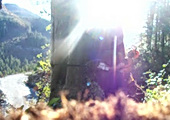 |
 |
 |
 |
"Falling 11 ft Cedar" |
"Big Douglas Fir" |
"Spruce Tree: 7 ft" |
"Bucking a Spruce" |
|
|
| |
|
|
 |
|
| |
|
|
| |
|
|
|
|
| |
Tree Songs
The Tree – a Song (MP3). 18 second audio clip. Music and lyrics by Tom Splitt. Vocals by Robert Johnson with Tom Splitt on piano. Tom Splitt is an American composer who lives in Colorado. He explains how a grove of big trees was the inspiration behind his composition: "This song is the fruit of an experience in a grove of old trees, after which sleep was impossible; apparently they were determined to see it written! As it happened, we were to perform at several conferences of mental health professionals soon thereafter. The song touched many hearts, reminding me of these immortal words of Beethoven; From the heart it has sprung, and to the heart it shall penetrate"
Tom Splitt. |
|
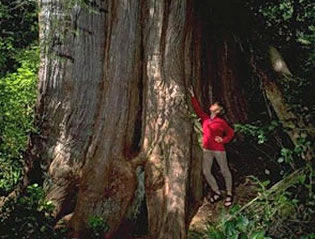 |
|
| |
|
|
|
|
| |
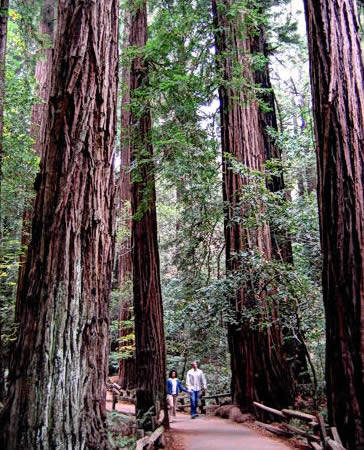 Cathedral Grove, Muir Woods, California Cathedral Grove, Muir Woods, California |
|
The Tree
The calm quiet strength of a tree
Anchored deep in the earth
Reaching high in the sky
The calm quiet strength of a tree
The calm quiet strength of a tree
Full of life from its roots
To the tiniest branch
The calm quiet strength of a tree
And oh, how it comforts me
How it teaches me
Without a sound
Then I realize at once
That this tree and I are one
In eternity
The calm quiet strength of a tree
From the weight of its trunk
To its delicate leaves
The calm quiet strength of a tree
The calm quiet strength of a tree
Showing anyone near
All the secrets of time
The calm quiet strength of a tree |
|
|
| |
|
|
|
|
| |
|
If A Tree Falls
by Bruce Cockburn, 1989
Rain forest
Mist and mystery
Teeming green
Green brain facing labotomy
Climate control centre for the world
Ancient cord of coexistence
Hacked by parasitic greedhead scam
From Sarawak to Amazonas
Costa Rica to mangy BC hills
Cortege rhythm of falling timber
If a tree falls in the forest does anybody hear?
If a tree falls in the forest does anybody hear?
Anybody hear the forest fall? |
|
|
 |
|
| |
|
|
 |
|
| |
|
|
| |
©
Credits & Contact |
|
| |
|
|
|
|

